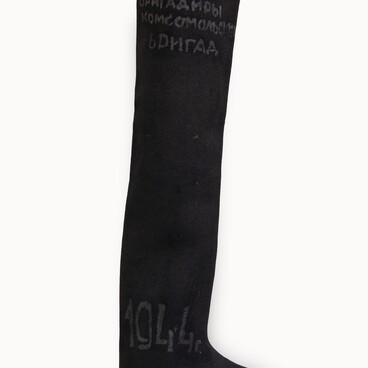This tunic used to belong to Vasily Stepanovich Agapitov. He was born in 1911. During the Great Patriotic War, he served as the communications officer of the 939th artillery regiment of the 368th rifle division, which in 1944 received the honorary titles of the Red Banner Division for crossing the Svir River and the liberation of Petrozavodsk, as well as the Pechenga Division for the liberation of the town of Kirkenes in Norway.
Vasily Agapitov fought on the territory of Karelia and in the Arctic. In 1944, he was awarded the medal “For Battle Merit” for ensuring uninterrupted telephone communication between batteries and the lines of infantry when the division crossed the Svir River.
During a turning maneuver on July 20 and 21, 1944, Vasily Agapitov laid a telephone cable over a distance of 15 km. However, it was 1.5 kilometers short. Sergeant Agapitov and Corporal Manayenko approached the enemy, cut out about 500 meters of their telephone line, and took away two coils of cable, thus ensuring communication along the necessary route. The mission of the turning maneuver was successfully accomplished.
The senior sergeant’s tunic, or “gymnastyorka”, with shoulder marks is a classic example of a Soviet soldier’s summer uniform during the Great Patriotic War. In accordance with the order of the Revolutionary Military Council of the USSR No. 190 of July 19, 1929, the tunics of privates and junior commanders were made of dark khaki cotton fabric with a turn-down collar, which was fastened with one uniform button and had sleeves with cuffs.
The upper part of the shirt was sewn from the sides and at the shoulders from two parts: front and back. The shirt was fastened with three buttons, with two patch pockets on the chest parallel to the buttons. They were covered with flaps, which were fastened with one button. Two buttons were sewn on the sleeves. Summer tunics came in six sizes.
On January 15, 1943, by order of the People’s Commissariat of Defense of the USSR No. 25, new uniforms and shoulder straps were introduced. The tunic continued to be used only as a service and field uniform. Instead of a turn-down collar, it received a band collar, which was better suited for wearing shoulder straps.
Vasily Agapitov fought on the territory of Karelia and in the Arctic. In 1944, he was awarded the medal “For Battle Merit” for ensuring uninterrupted telephone communication between batteries and the lines of infantry when the division crossed the Svir River.
During a turning maneuver on July 20 and 21, 1944, Vasily Agapitov laid a telephone cable over a distance of 15 km. However, it was 1.5 kilometers short. Sergeant Agapitov and Corporal Manayenko approached the enemy, cut out about 500 meters of their telephone line, and took away two coils of cable, thus ensuring communication along the necessary route. The mission of the turning maneuver was successfully accomplished.
The senior sergeant’s tunic, or “gymnastyorka”, with shoulder marks is a classic example of a Soviet soldier’s summer uniform during the Great Patriotic War. In accordance with the order of the Revolutionary Military Council of the USSR No. 190 of July 19, 1929, the tunics of privates and junior commanders were made of dark khaki cotton fabric with a turn-down collar, which was fastened with one uniform button and had sleeves with cuffs.
The upper part of the shirt was sewn from the sides and at the shoulders from two parts: front and back. The shirt was fastened with three buttons, with two patch pockets on the chest parallel to the buttons. They were covered with flaps, which were fastened with one button. Two buttons were sewn on the sleeves. Summer tunics came in six sizes.
On January 15, 1943, by order of the People’s Commissariat of Defense of the USSR No. 25, new uniforms and shoulder straps were introduced. The tunic continued to be used only as a service and field uniform. Instead of a turn-down collar, it received a band collar, which was better suited for wearing shoulder straps.



